 Leading Blog | Posts by Month |
 Leading Blog | Posts by Month |
03.31.17

LeadershipNow 140: March 2017 Compilation
See more on
Posted by Michael McKinney at 08:13 AM
03.27.17

The Outward Mindset: Seeing Beyond Ourselves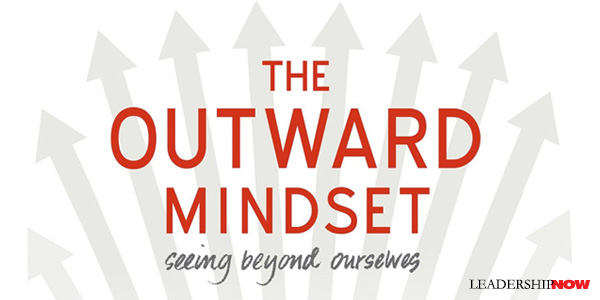
A An outward mindset doesn’t come naturally. We have to consciously change how we think about others. In The Outward Mindset, the Arbinger Institute reports that “the biggest lever for change is not a change in self-belief but a fundamental change in the way one sees and regards one’s connections with and obligations to others.” People and organizations get stuck when they have an inward mindset because when we are focused on ourselves and our needs, our reality becomes distorted. An inward mindset limits our possibilities and negatively affects our behavior and thus our relationships. Arbinger reminds us that an inward mindset and introspection are not the same thing. “One can introspect in a self-centered way, which would indicate an inward mindset. However, a person also can introspect about one’s connections with others, which is the very essence of what we are calling outwardness. Sometimes it is helpful to look inside to see how one is connected with what is outside.” Moving from an inward mindset to an outward mindset is more than a surface adjustment or behavioral change alone. It requires a change in how we see and think about others. How we see and respond to others is not so much about them as it is a reflection of what is going on inside of us. We often fixate on other’s shortcomings so we don’t have to deal with our own. Inward-mindset people and organizations do things. Outward-mindset people and organizations help others to be able to do things.” It is possible to be an inward-mindset person or organization masquerading as an outward-mindset person or organization if you aren’t paying attention to the needs, objectives, and challenges of those you are supposedly doing the work for. Whose needs are your primary focus? Arbinger has discovered that those who consistently work with an outward mindset follow a pattern. They:
An outward-mindset begins with you. “While the goal in shifting mindsets is to get everyone turned toward each other, accomplishing this goal is possible only if people are prepared to turn their mindsets toward others with no expectation that others will change their mindsets in return. This capability—to change the way I see and work with others regardless of whether they change—overcomes the biggest impediment to mindset change: the natural, inward-mindset inclination to wait for others to change before doing anything different oneself.” This, of course, is true leadership. To begin:
Take the Mindset Audit online.  
Posted by Michael McKinney at 03:21 PM
03.24.17

The Caterpillar's Edge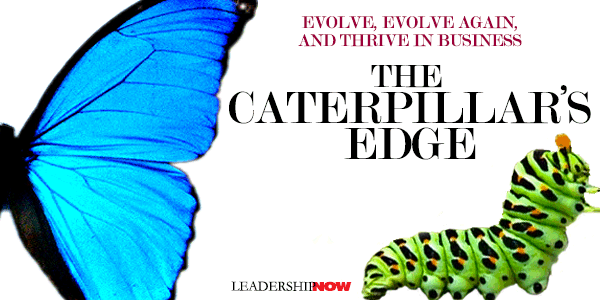
T Sid Mohasseb writes in The Caterpillars Edge that “to realize an improved future you must purposefully leave the past behind, and embrace the uncertainty ahead—constantly and without fear. You must evolve, then evolve again and thrive.” The problem as Mohasseb sees it is that many leaders are stuck in their approach to planning and execution. “They are guided by old habits formed in an era when competition was more static.” The data you are using can’t be captured in a fixed plan or you’ll have an excellent strategy for the year before. Your planning and execution needs to be more dynamic than that. We need a new and more agile approach. “The world will not wait while you contemplate, take time to gather enough data to be exhaustive in your analysis, and then build consensus around actions.” You can improve your “likelihood of winning by constantly reading and applying the incoming data points.” “You must learn and live and compete in an uncertain and always changing reality.” Prefer change to the comfort of stability. There are three crucial rules to be applied here: 1. Align with Uncertainty—Adjust to the dynamic world around you. Be prepared to shift your focus at all times. The market is shifting. By the time you transform, the advantage you wanted may be long gone. 2. Appreciate Reality—Understand what is practical and achievable by you and your company. You can evolve over and over. 3. Aspire for More—Seek more data, more analysis, and more “Aha” moments or move faster to reach the moments of insight, where the solutions to problems become clear. McKinsey reports that eight out of ten times strategists focus on known hypothesis—opportunities that have been examined in the past or are already evident. “Most people use analytics in the context of consumer-level transactions. But there is no lasting strategic advantage. When people claim that they are competitive because they are using analytics, that’s just the flavor of the day. Now unless you tell me that you have used data analytics in order to find a new product ground, a new design, and a new market, you are not strategic . . . as opposed to let’s sell more shoes to the guys who are buying shoes . . . what is being done for the most part today is a kind of a tit for tat, and that’s what I see most people calling gaining competitive advantage.” Optimizing today’s processes for greater efficiency does not necessarily offer an advantage for tomorrow. Use the force and create the future. Don’t use the data to justify your actions, use it to discover advantages. It’s not the analytics, but the execution. Analytics is just and tool and soon will be found and used by everyone everywhere. As that occurs, the “business basics of good strategy and execution will, once again, drive the lasting victories.” A winning strategy must be adaptable from the start. Be prepared to improvise. Selected Caterpillar Edge advice:

Posted by Michael McKinney at 12:34 PM
03.22.17

5 Critical Skills You Will Need to Hit the Ground Running After College
J There is Life After College is a book that every student should read—twice. Frankly, it would hurt those already in the workplace to read it as the ground is shifting under our feet as well. Employers are looking for T-shaped individuals. The vertical bar represents depth of knowledge and the horizontal bar represents the ability to work across a variety of complex subject areas with ease and confidence. Something a liberal arts education is designed to do. Selingo notes that too many undergraduates want to be spoon-fed. “They sit back and wait for professors to deliver lessons in the classroom. They participate in campus life but too often from the sidelines, so they lack and deep engagement in activities that provide much-needed skills for the job market. They fail to cultivate relationships with professors or staff on campus who might lend advice or act as mentors. And they are reluctant to chase after experiences—whether undergraduate research, study abroad, or internships—that help them discover their passions and arm them with the interpersonal skills so in demand by employers today.” Selingo has distilled a lot of wisdom into five often overlapping skills needed to succeed in your career and life. (You see these concepts are appearing more and more in leadership development studies as well.) I’ve listed them here with brief outtakes for each from the chapter. The book provides much more detail and practical career and life advice that is well worth taking the time to consider. 1. Be Curious, Ask Questions, and Be a Learner for Life The recent graduates who succeed in their careers are flexible about how they learn. “They have ideas and act on them,” said Tim Brown, CEO of IDEO. “Being able to get stuff done is a capacity that is rather important.” Most of all he’s looking for a mind-set with creativity, passion, and empathy at its root. “I want diversity of experiences in college that have exercised their brain,” Brown said. 2. Build an Expertise, Take Risks, and Learn the Meaning of Grit “We see a lot of transferable skills in athletes,” Marie Artim, vice president of talent acquisition at Enterprise, told me. Enterprise is not alone. As employers search for signals that someone is ready for a job beyond achieving the baseline bachelor’s degree, participation in collegiate athletics is seen by many as one clear indicator of commitment and drive in a generation of college graduates often lacking both. 3. Every Job is a Tech Job Understanding the programming language behind the apps on your iPhone or the basics of artificial intelligence is now seen as basic foundational skills by many employers. Learning to program is much like learning a second language was in the twentieth century: You might not become proficient enough to move overseas, but you could get by if you traveled to a particular country. 4. Learn to Deal with Ambiguity “Excelling at any job is about doing the things you weren’t asked to do,” said Mary Egan, founder of Gatheredtable, a Seattle-based start-up, and former senior vice president for strategy and corporate development at Starbucks. “This generation is not as comfortable with figuring out what to do.” 5. Be Humble and Learn from Your Peers and Mentors People who manage recent college graduates all had the same complaint about their new hires: they’re too impatient about their careers and unrealistic about their roles within a company. A friend who is my age and a manager at a major media company told me about new graduates who applied for senior roles after less than a year on the job and who were flabbergasted when they didn’t get the promotion, which went to someone with ten or twenty years more experience. Selingo emphasizes that what you do in college (and therefore what you become—who you are) is typically more important than where you go.  
Posted by Michael McKinney at 12:27 AM
03.20.17

Leaders Made Here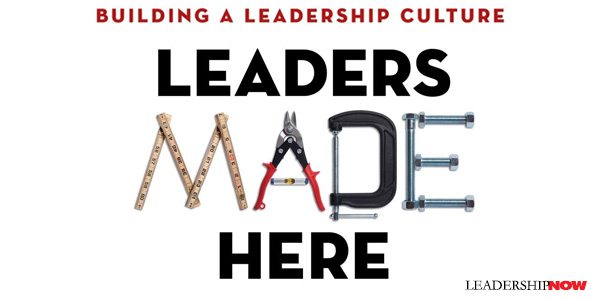
T This occurs for a number of reasons: They don’t see the immediate need, they don’t understand how or are too busy to do it, they don’t walk the talk, and their own insecurities. Leadership cultures are built from the top down. Miller describes a leadership culture is one where “leaders are routinely and systematically developed, and you have a surplus of leaders ready for the next opportunity or challenge.” Leaders Made Here is the story of a typical organization that found themselves short when they needed more leaders to fill some gaps and what they did to create a leadership culture. Frankly, a leadership culture does more than to have leaders in waiting. It provides for the growth and development of all people throughout the organization. It makes whatever you’re doing work better. To create a leadership culture, Miller boils it down to five ongoing commitments: 1. Define it.
There’s certainly real power in a common definition of leadership; there’s even more power in a common leadership skill set. 2. Teach it.
3. Practice it.
We discovered that for most people—leaders included—the natural tendency is to avoid risk. So, when a new project would come along, the leader responsible would assign a seasoned leader regardless of opportunity. It did not matter what was needed; our existing leaders rarely gave an emerging or inexperienced leader a shot. This did nothing to help young leaders grow and develop in a real-world setting. 4. Measure it.
A scorecard should answer at least four questions: What is most important now? Is our performance improving or declining? What impact are our interventions having? And are we winning? 5. Model it.
Leaders Made Here is not a bold initiative that comes and goes. It must become what the organization is. It has to become part of the organizational DNA. 
Posted by Michael McKinney at 08:44 PM
03.15.17

Intelligent Restraint: Pacing for Growth
W Athletes know that the right pace in both training and racing is key to winning. It is a common belief that pushing ourselves or our organizations past our limits is the best strategy fro growth. But if you go too fast or push too hard you cannot only burn out but cause injuries and setbacks. At the same time, if you go too slow, you will get left in the dust. Find the right pace is key to successful growth and long-term success. Long-term success also requires that we execute our core business today while preparing ourselves for the future. In Pacing for Growth, Alison Eyring addresses this tension and how we can find the pace that avoids the wasted effort and the frustrating boom-splat cycles common to growth initiatives. The concept is called Intelligent Restraint. Intelligent Restraint is basically operating within the limits of the capacity and capabilities we have today and no further while we also build a base of the right capabilities for long term enduring growth. The three core principles of Intelligent Restraint are: Principle One: Capacity determines how far and fast you can go. Maximum capacity is the highest level of performance at which a system can perform without breaking down. When we understand the gaps between performance and capacity and how maximum capacity in the future will be different from today, we can create a program to build capabilities that increase capacity. Principle Two: The right capabilities increase capacity. The key is to be crystal clear what capabilities are most critical for growth in your business. What are the critical few capabilities your strategy requires you to execute fabulously well? Principle Three: The right pace wins the race. Growth leaders understand how and when to push faster and when to slow things down. In a race, we need to conserve some energy to maintain a fast pace and we need to perseverance to sustain this pace even when it become uncomfortable. Growth requires trade-offs like exploring new opportunities while exploiting existing assets. Eyring says there are three rules to keep in mind. Rule #1: Focus overrules vision. Vision is important and gets you going but focus is what gets you over the finish line. By learning to focus and then align people and pother resources to that focus, you can conserve time and energy that can be used to build new capabilities for growth. Making focused choices is Intelligent Restraint at work. Rule #2: Routines beat strengths. Strengths are useful but they can become a liability when overused. The right routines efficiently shape new ways of thinking and behaving that are need for growth. When we repeat the same thing over and over, we can perfect our technique, But when we repeat progressively challenging routines, we build endurance. Rule #3: Exert then Recover. To deliver results and build capacity for growth at the same time requires high levels of exertion that consumes personal and organizational energy that must be replenished. As a growth leader, you may need to intentionally slow things down. A sign that you’re growing at the wrong pace is that you lack the capacity or infrastructure to support what you trying to do. This results in chronic mistakes, poor customer service, and in some industries, safety violations and injuries. You know you are at the right pace when you can deliver the results intended by the growth initiative while at the same time having the space to give thought to and build for future growth. Eyring offers an online assessment to determine if your organization is setting the right pace on her Organization Solutions web site. 
Posted by Michael McKinney at 11:40 PM
03.13.17

Create the Target Before You Shoot the Arrow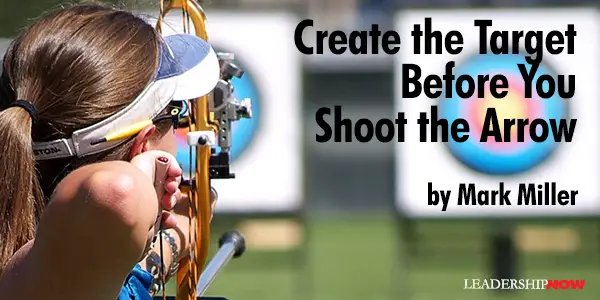
I Having just returned from our annual meeting with over 5,000 chicken people present, I am thankful we took the time to draw the target before we shot the arrow. We will see what the attendees have to say, but preliminary reports are positive. I think the event hit the mark. Here’s the leadership lesson that comes to mind as I reflect on the event. One of the reasons it was a success—not the only reason, but one of them—is that we decided what we were trying to accomplish before we created the event. We drew the target BEFORE we shot the arrow. I’m wondering how often, as a leader, we fail to clearly define the target. I think about all the times my leadership efforts have fallen short . . . how many of those failures can be attributed, directly or indirectly, to an unclear target or goal? There are many things leaders CANNOT do for their people. However, clarity regarding intent should never be in short supply. People must always know what they are trying to accomplish. The power of clarity transcends targets, goals, and objectives – it includes vision, values, and strategic intent, as well as other tactical issues. But what we are trying to accomplish cannot get lost in the process. When you identify the target with crystal clarity, I think you may be amazed at how often your team will hit the mark.  His latest book, Leaders Made Here, describes how to nurture leaders throughout the organization, from the front lines to the executive ranks and outlines a clear and replicable approach to creating the leadership bench every organization needs. 
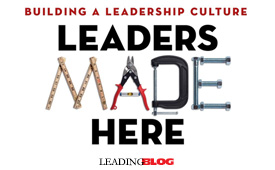 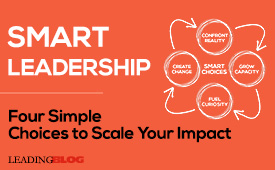
Posted by Michael McKinney at 01:22 AM
03.08.17

Humility Casts a Wide Net
HUMILITY casts a wide net and makes possible the work of leadership. Nothing facilitates community, collaboration, and innovation like humility. In Humility is the New Smart, Ed Hess and Katherine Ludwig define humility as “a mindset about oneself that is open-minded, self-accurate, and not all about me, and that enables one to embrace the world as it is in the pursuit of human excellence.” Their definition encompasses the mind of a leader that will be able to lead in a changing and uncertain world. Humility is inclusive. It is inclusive of others ideas, others needs, others strengths, other contributions, and the realities that exist outside of our own head. A humble leader asks more questions and is open to more answers thus deepening the pool of resources they have to draw upon. But it requires a strength of character. As senior vice president of the NBA’s Orlando Magic, Pat Williams writes in Humility: The Secret Ingredient of Success:
Additionally,
Humility is the antidote to insecurity that often plagues us. A lack of humility actually drives insecurity. Humility makes your strengths productive and multiplies the strengths of others. Humility acknowledges a world beyond our own thinking and minimizes our own limitations. A good leader knows this and acts accordingly to produce the best results. Do you have the strength to be humble?
Posted by Michael McKinney at 10:50 PM
03.06.17

How Do We Get Outside Our Comfort Zone?
YOU'VE NO DOUBT HEARD that it is outside our comfort zone where the magic happens. But how do we get outside our comfort zone? It’s not always easy in some cases too stressful to consider. Andy Molinsky gives us some practical first steps in Reach: A New Strategy to Help You Step Outside Your Comfort Zone, Rise to the Challenge and Build Confidence. We often fail to get outside our comfort zone because of the feeling that it’s too big a reach (which is why they’re outside your comfort zone): “It’s not me,” “People won’t like this version of me,” “It’s embarrassing because I’m clearly not good at this,” “Why should I have to do this,” and/or “Maybe this isn’t something I should be doing.” So commonly, we do nothing. We avoid it altogether. Or we only do it half-heartedly. All of these things sabotage our efforts. So the question to ask yourself is, "If I could erase the anxiety and distress, is it something I’d like to be able to do?" Molinsky has interviewed and also observed people in many different professions and walks of life. And the stories he includes from managers, executives, priests, baristas, stay-at-home-moms, singers, actors and performers, are helpful and relatable. And although these people are very different, there is a common theme. He has found that those most successful at getting outside of their comfort zones have three things going for them: Conviction—Making Sure the Gain is Worth the Discomfort Customization—Designing a Personalized Baby-Step Plan Clarity—Getting Some Perspective on Your Fears Here are Five Comfort Zone Myths to consider: Myth #1: All it takes to step outside your comfort zone is taking a leap.

Posted by Michael McKinney at 08:06 AM
03.03.17

Thank You for Being Late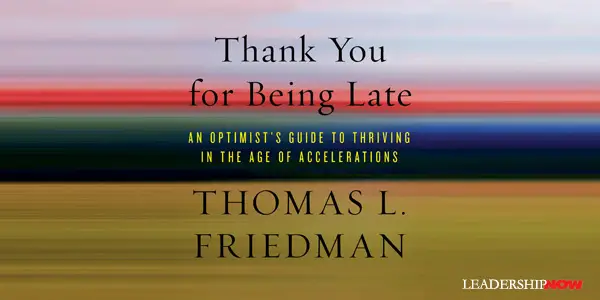
As he notes, it more than just change it is reshaping that is taking place. It’s hard for any of us to keep up. “In such a time, opting to pause and reflect, rather than panic or withdraw, is a necessity. It is not a luxury or a distraction—it is a way to increase the odds that you’ll better understand, and engage productively with, the world around you.” Friedman’s title, Thank You for Being Late, comes from realizing that a guest’s tardiness to a meeting gave him time to just sit and think. And he was better for it. So, “Thank you for being late.” Thank You for Being Late succeeds in presenting a better understanding of why the world is the way it is. What follows is a small selection of thoughts and analysis of and prescriptions for the world we live in: ☙ As the world becomes more interdependent and complex, it becomes more vital than ever to widen your aperture and to synthesize more perspectives. ☙ Creativity becomes, in part, about asking the best questions. ☙ You can’t just show up. You need a plan to succeed. You have to know more, you have to update what you know more often, and you have to do more creative things with it. Self-motivation is now so much more important. ☙ It is so easy to forget that many, many people in America don’t have a professional network, an alumni network, two parents, or in some cases anyone around them with a job, to consult about how to get one. ☙ In a world of so many choices, it’s hard to know what to do. ☙ Social media is good for collective sharing, but not always so great for collective building; good for collective destruction, but maybe not so good for collective construction; fantastic for generating a flash mob, but not so good at generating a flash consensus on a party platform or a constitution. ☙ Quoting Jeffrey Garten, the former dean of the Yale School of Management: Maybe this is overly romantic, but I think leadership is going to require the ability to come to grips with values and ethics. The more technological we get, the more we need people who have a much broader framework. You’ll be able to hire the technologist to make systems work, but in terms of the goals, that takes a different kind of leader. ☙ A number of technological forces came together to create an exponential step in change in the power of men and machines—much faster than we have been able to reshape our institutions, our laws, and our modes of leadership. Quoting Dov Seidman: Technology creates possibilities for new behaviors and experiences and connection, but it takes human beings to make the behaviors principled, the experiences meaningful and the connections deeper and rooted in shared values and aspirations. ☙ No better source of restraint then a strong community. ☙ It is only when people relax their hearts and their minds that they are open to hear and engage with others, and healthy communities create a context for that. 
Posted by Michael McKinney at 11:07 AM
03.01.17

First Look: Leadership Books for March 2017Here's a look at some of the best leadership books to be released in March.    
For bulk orders call 1-800-423-8273
 Build your leadership library with these specials on over 39 titles. All titles are at least 40% off the list price and are available only in limited quantities. "A book must be the axe for the frozen sea within us." — Franz Kafka
Posted by Michael McKinney at 08:07 AM
|
BUILD YOUR KNOWLEDGE


How to Do Your Start-Up Right STRAIGHT TALK FOR START-UPS 
Grow Your Leadership Skills NEW AND UPCOMING LEADERSHIP BOOKS 
Leadership Minute BITE-SIZE CONCEPTS YOU CAN CHEW ON 
Classic Leadership Books BOOKS TO READ BEFORE YOU LEAD |
|